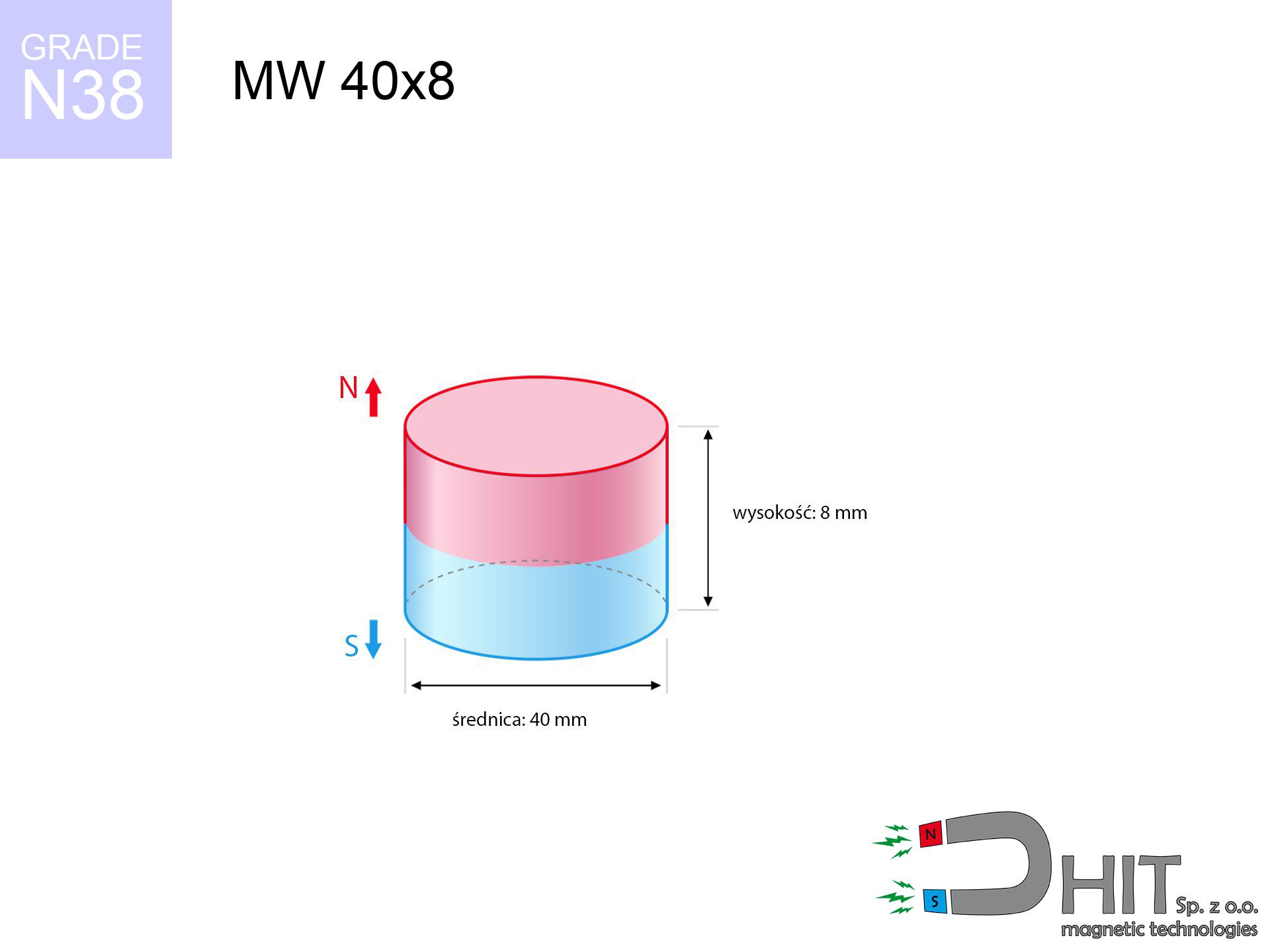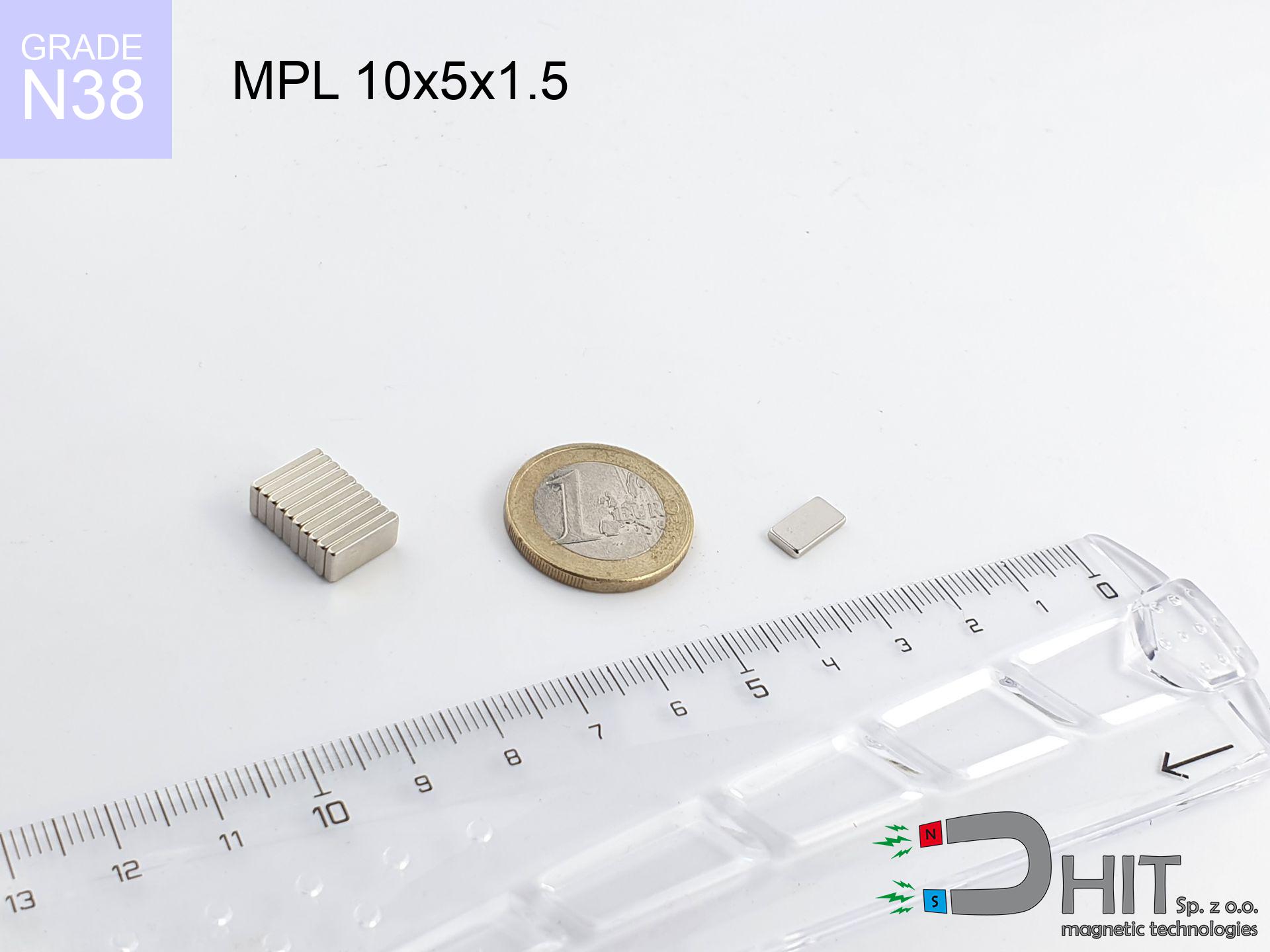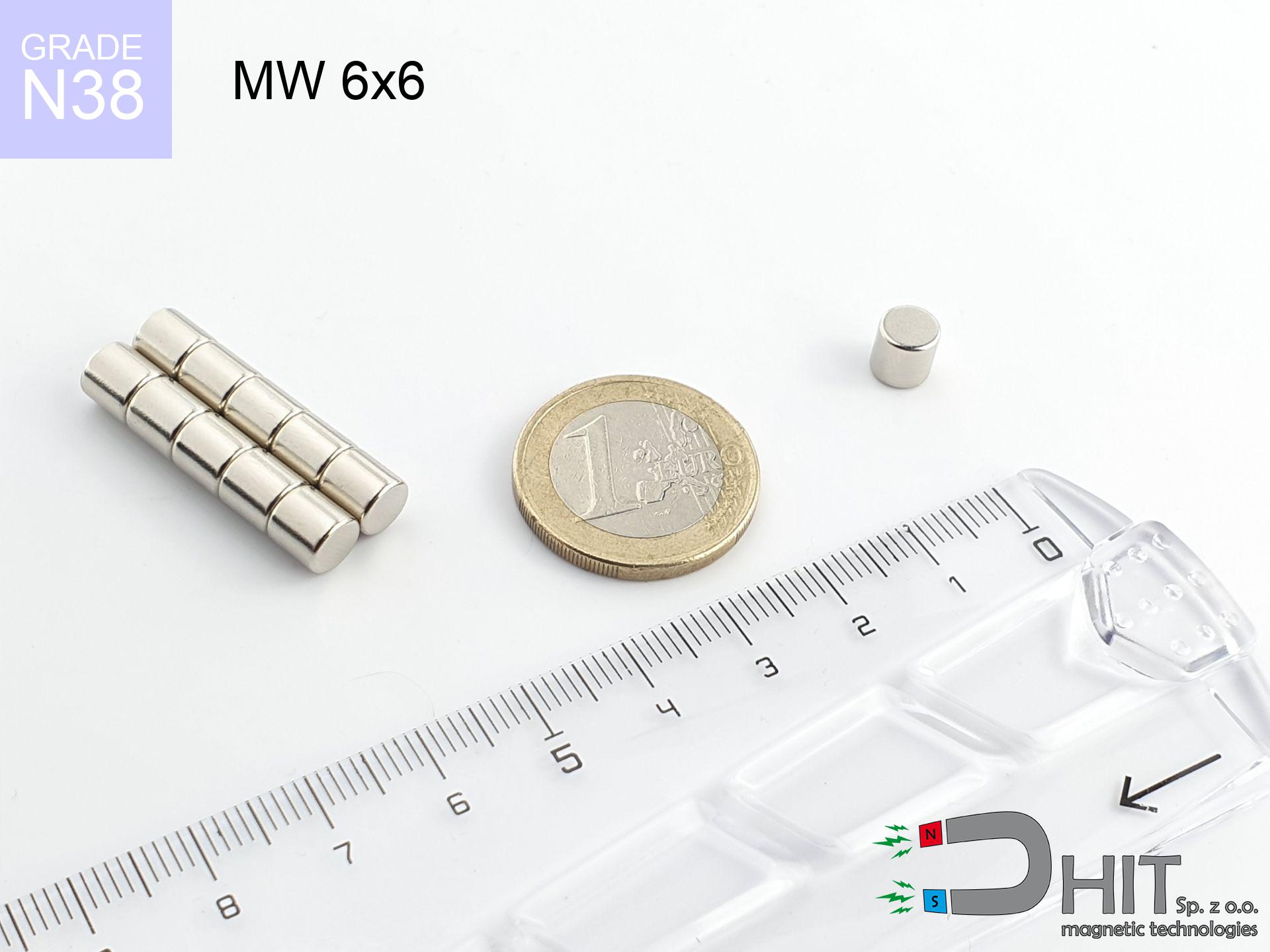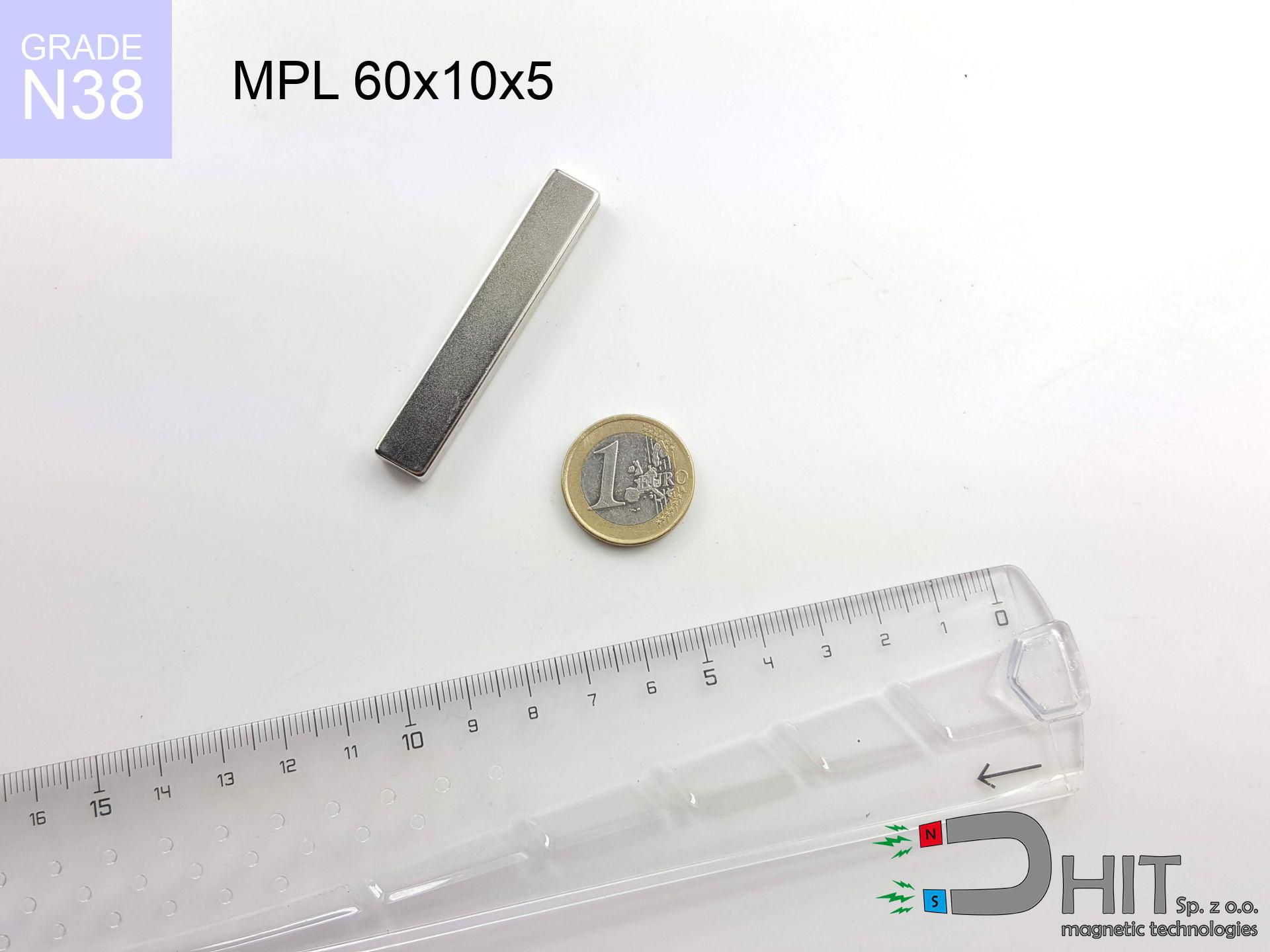MW 40x8 / N38 - cylindrical magnet
cylindrical magnet
Catalog no 010069
GTIN/EAN: 5906301810681
Diameter Ø
40 mm [±0,1 mm]
Height
8 mm [±0,1 mm]
Weight
75.4 g
Magnetization Direction
↑ axial
Load capacity
20.43 kg / 200.39 N
Magnetic Induction
230.22 mT / 2302 Gs
Coating
[NiCuNi] Nickel
31.27 ZŁ with VAT / pcs + price for transport
25.42 ZŁ net + 23% VAT / pcs
bulk discounts:
Need more?
Pick up the phone and ask
+48 22 499 98 98
or send us a note using
inquiry form
the contact section.
Weight along with structure of magnets can be estimated on our
magnetic mass calculator.
Same-day shipping for orders placed before 14:00.
Technical parameters of the product - MW 40x8 / N38 - cylindrical magnet
Specification / characteristics - MW 40x8 / N38 - cylindrical magnet
| properties | values |
|---|---|
| Cat. no. | 010069 |
| GTIN/EAN | 5906301810681 |
| Production/Distribution | Dhit sp. z o.o. |
| Country of origin | Poland / China / Germany |
| Customs code | 85059029 |
| Diameter Ø | 40 mm [±0,1 mm] |
| Height | 8 mm [±0,1 mm] |
| Weight | 75.4 g |
| Magnetization Direction | ↑ axial |
| Load capacity ~ ? | 20.43 kg / 200.39 N |
| Magnetic Induction ~ ? | 230.22 mT / 2302 Gs |
| Coating | [NiCuNi] Nickel |
| Manufacturing Tolerance | ±0.1 mm |
Magnetic properties of material N38
| properties | values | units |
|---|---|---|
| remenance Br [min. - max.] ? | 12.2-12.6 | kGs |
| remenance Br [min. - max.] ? | 1220-1260 | mT |
| coercivity bHc ? | 10.8-11.5 | kOe |
| coercivity bHc ? | 860-915 | kA/m |
| actual internal force iHc | ≥ 12 | kOe |
| actual internal force iHc | ≥ 955 | kA/m |
| energy density [min. - max.] ? | 36-38 | BH max MGOe |
| energy density [min. - max.] ? | 287-303 | BH max KJ/m |
| max. temperature ? | ≤ 80 | °C |
Physical properties of sintered neodymium magnets Nd2Fe14B at 20°C
| properties | values | units |
|---|---|---|
| Vickers hardness | ≥550 | Hv |
| Density | ≥7.4 | g/cm3 |
| Curie Temperature TC | 312 - 380 | °C |
| Curie Temperature TF | 593 - 716 | °F |
| Specific resistance | 150 | μΩ⋅cm |
| Bending strength | 250 | MPa |
| Compressive strength | 1000~1100 | MPa |
| Thermal expansion parallel (∥) to orientation (M) | (3-4) x 10-6 | °C-1 |
| Thermal expansion perpendicular (⊥) to orientation (M) | -(1-3) x 10-6 | °C-1 |
| Young's modulus | 1.7 x 104 | kg/mm² |
Physical analysis of the assembly - data
Presented data constitute the direct effect of a mathematical calculation. Values were calculated on models for the class Nd2Fe14B. Operational parameters may differ. Use these calculations as a preliminary roadmap when designing systems.
Table 1: Static force (pull vs distance) - interaction chart
MW 40x8 / N38
| Distance (mm) | Induction (Gauss) / mT | Pull Force (kg) | Risk Status |
|---|---|---|---|
| 0 mm |
2302 Gs
230.2 mT
|
20.43 kg / 20430.0 g
200.4 N
|
crushing |
| 1 mm |
2235 Gs
223.5 mT
|
19.25 kg / 19252.0 g
188.9 N
|
crushing |
| 2 mm |
2156 Gs
215.6 mT
|
17.92 kg / 17917.4 g
175.8 N
|
crushing |
| 3 mm |
2068 Gs
206.8 mT
|
16.49 kg / 16490.6 g
161.8 N
|
crushing |
| 5 mm |
1875 Gs
187.5 mT
|
13.56 kg / 13556.7 g
133.0 N
|
crushing |
| 10 mm |
1375 Gs
137.5 mT
|
7.29 kg / 7287.4 g
71.5 N
|
strong |
| 15 mm |
959 Gs
95.9 mT
|
3.54 kg / 3542.3 g
34.8 N
|
strong |
| 20 mm |
661 Gs
66.1 mT
|
1.68 kg / 1684.9 g
16.5 N
|
weak grip |
| 30 mm |
328 Gs
32.8 mT
|
0.41 kg / 414.2 g
4.1 N
|
weak grip |
| 50 mm |
105 Gs
10.5 mT
|
0.04 kg / 42.3 g
0.4 N
|
weak grip |
Table 2: Slippage load (vertical surface)
MW 40x8 / N38
| Distance (mm) | Friction coefficient | Pull Force (kg) |
|---|---|---|
| 0 mm | Stal (~0.2) |
4.09 kg / 4086.0 g
40.1 N
|
| 1 mm | Stal (~0.2) |
3.85 kg / 3850.0 g
37.8 N
|
| 2 mm | Stal (~0.2) |
3.58 kg / 3584.0 g
35.2 N
|
| 3 mm | Stal (~0.2) |
3.30 kg / 3298.0 g
32.4 N
|
| 5 mm | Stal (~0.2) |
2.71 kg / 2712.0 g
26.6 N
|
| 10 mm | Stal (~0.2) |
1.46 kg / 1458.0 g
14.3 N
|
| 15 mm | Stal (~0.2) |
0.71 kg / 708.0 g
6.9 N
|
| 20 mm | Stal (~0.2) |
0.34 kg / 336.0 g
3.3 N
|
| 30 mm | Stal (~0.2) |
0.08 kg / 82.0 g
0.8 N
|
| 50 mm | Stal (~0.2) |
0.01 kg / 8.0 g
0.1 N
|
Table 3: Wall mounting (shearing) - vertical pull
MW 40x8 / N38
| Surface type | Friction coefficient / % Mocy | Max load (kg) |
|---|---|---|
| Raw steel |
µ = 0.3
30% Nominalnej Siły
|
6.13 kg / 6129.0 g
60.1 N
|
| Painted steel (standard) |
µ = 0.2
20% Nominalnej Siły
|
4.09 kg / 4086.0 g
40.1 N
|
| Oily/slippery steel |
µ = 0.1
10% Nominalnej Siły
|
2.04 kg / 2043.0 g
20.0 N
|
| Magnet with anti-slip rubber |
µ = 0.5
50% Nominalnej Siły
|
10.22 kg / 10215.0 g
100.2 N
|
Table 4: Material efficiency (substrate influence) - sheet metal selection
MW 40x8 / N38
| Steel thickness (mm) | % power | Real pull force (kg) |
|---|---|---|
| 0.5 mm |
|
1.02 kg / 1021.5 g
10.0 N
|
| 1 mm |
|
2.55 kg / 2553.8 g
25.1 N
|
| 2 mm |
|
5.11 kg / 5107.5 g
50.1 N
|
| 5 mm |
|
12.77 kg / 12768.8 g
125.3 N
|
| 10 mm |
|
20.43 kg / 20430.0 g
200.4 N
|
Table 5: Thermal resistance (stability) - thermal limit
MW 40x8 / N38
| Ambient temp. (°C) | Power loss | Remaining pull | Status |
|---|---|---|---|
| 20 °C | 0.0% |
20.43 kg / 20430.0 g
200.4 N
|
OK |
| 40 °C | -2.2% |
19.98 kg / 19980.5 g
196.0 N
|
OK |
| 60 °C | -4.4% |
19.53 kg / 19531.1 g
191.6 N
|
|
| 80 °C | -6.6% |
19.08 kg / 19081.6 g
187.2 N
|
|
| 100 °C | -28.8% |
14.55 kg / 14546.2 g
142.7 N
|
Table 6: Magnet-Magnet interaction (repulsion) - forces in the system
MW 40x8 / N38
| Gap (mm) | Attraction (kg) (N-S) | Repulsion (kg) (N-N) |
|---|---|---|
| 0 mm |
41.05 kg / 41054 g
402.7 N
3 871 Gs
|
N/A |
| 1 mm |
39.92 kg / 39925 g
391.7 N
4 540 Gs
|
35.93 kg / 35932 g
352.5 N
~0 Gs
|
| 2 mm |
38.69 kg / 38687 g
379.5 N
4 469 Gs
|
34.82 kg / 34818 g
341.6 N
~0 Gs
|
| 3 mm |
37.38 kg / 37376 g
366.7 N
4 393 Gs
|
33.64 kg / 33638 g
330.0 N
~0 Gs
|
| 5 mm |
34.59 kg / 34588 g
339.3 N
4 226 Gs
|
31.13 kg / 31129 g
305.4 N
~0 Gs
|
| 10 mm |
27.24 kg / 27242 g
267.2 N
3 750 Gs
|
24.52 kg / 24518 g
240.5 N
~0 Gs
|
| 20 mm |
14.64 kg / 14644 g
143.7 N
2 750 Gs
|
13.18 kg / 13180 g
129.3 N
~0 Gs
|
| 50 mm |
1.65 kg / 1645 g
16.1 N
922 Gs
|
1.48 kg / 1481 g
14.5 N
~0 Gs
|
Table 7: Safety (HSE) (electronics) - warnings
MW 40x8 / N38
| Object / Device | Limit (Gauss) / mT | Safe distance |
|---|---|---|
| Pacemaker | 5 Gs (0.5 mT) | 15.5 cm |
| Hearing aid | 10 Gs (1.0 mT) | 12.5 cm |
| Timepiece | 20 Gs (2.0 mT) | 9.5 cm |
| Mobile device | 40 Gs (4.0 mT) | 7.5 cm |
| Car key | 50 Gs (5.0 mT) | 7.0 cm |
| Payment card | 400 Gs (40.0 mT) | 3.0 cm |
| HDD hard drive | 600 Gs (60.0 mT) | 2.5 cm |
Table 8: Impact energy (kinetic energy) - collision effects
MW 40x8 / N38
| Start from (mm) | Speed (km/h) | Energy (J) | Predicted outcome |
|---|---|---|---|
| 10 mm |
19.96 km/h
(5.54 m/s)
|
1.16 J | |
| 30 mm |
29.12 km/h
(8.09 m/s)
|
2.47 J | |
| 50 mm |
37.17 km/h
(10.32 m/s)
|
4.02 J | |
| 100 mm |
52.50 km/h
(14.58 m/s)
|
8.02 J |
Table 9: Anti-corrosion coating durability
MW 40x8 / N38
| Technical parameter | Value / Description |
|---|---|
| Coating type | [NiCuNi] Nickel |
| Layer structure | Nickel - Copper - Nickel |
| Layer thickness | 10-20 µm |
| Salt spray test (SST) ? | 24 h |
| Recommended environment | Indoors only (dry) |
Table 10: Construction data (Flux)
MW 40x8 / N38
| Parameter | Value | SI Unit / Description |
|---|---|---|
| Magnetic Flux | 33 553 Mx | 335.5 µWb |
| Pc Coefficient | 0.29 | Low (Flat) |
Table 11: Hydrostatics and buoyancy
MW 40x8 / N38
| Environment | Effective steel pull | Effect |
|---|---|---|
| Air (land) | 20.43 kg | Standard |
| Water (riverbed) |
23.39 kg
(+2.96 kg Buoyancy gain)
|
+14.5% |
1. Wall mount (shear)
*Warning: On a vertical wall, the magnet holds merely ~20% of its perpendicular strength.
2. Efficiency vs thickness
*Thin metal sheet (e.g. computer case) severely weakens the holding force.
3. Thermal stability
*For N38 grade, the critical limit is 80°C.
4. Demagnetization curve and operating point (B-H)
chart generated for the permeance coefficient Pc (Permeance Coefficient) = 0.29
The chart above illustrates the magnetic characteristics of the material within the second quadrant of the hysteresis loop. The solid red line represents the demagnetization curve (material potential), while the dashed blue line is the load line based on the magnet's geometry. The Pc (Permeance Coefficient), also known as the load line slope, is a dimensionless value that describes the relationship between the magnet's shape and its magnetic stability. The intersection of these two lines (the black dot) is the operating point — it determines the actual magnetic flux density generated by the magnet in this specific configuration. A higher Pc value means the magnet is more 'slender' (tall relative to its area), resulting in a higher operating point and better resistance to irreversible demagnetization caused by external fields or temperature. A value of 0.42 is relatively low (typical for flat magnets), meaning the operating point is closer to the 'knee' of the curve — caution is advised when operating at temperatures near the maximum limit to avoid strength loss.
Material specification
| iron (Fe) | 64% – 68% |
| neodymium (Nd) | 29% – 32% |
| boron (B) | 1.1% – 1.2% |
| dysprosium (Dy) | 0.5% – 2.0% |
| coating (Ni-Cu-Ni) | < 0.05% |
Ecology and recycling (GPSR)
| recyclability (EoL) | 100% |
| recycled raw materials | ~10% (pre-cons) |
| carbon footprint | low / zredukowany |
| waste code (EWC) | 16 02 16 |
Other proposals
Pros and cons of neodymium magnets.
Pros
- They virtually do not lose power, because even after 10 years the performance loss is only ~1% (in laboratory conditions),
- Magnets very well resist against demagnetization caused by ambient magnetic noise,
- The use of an metallic coating of noble metals (nickel, gold, silver) causes the element to be more visually attractive,
- Magnetic induction on the working part of the magnet turns out to be maximum,
- Through (appropriate) combination of ingredients, they can achieve high thermal resistance, enabling functioning at temperatures approaching 230°C and above...
- In view of the possibility of flexible forming and adaptation to individualized projects, NdFeB magnets can be created in a broad palette of shapes and sizes, which makes them more universal,
- Universal use in modern industrial fields – they are utilized in mass storage devices, brushless drives, precision medical tools, also other advanced devices.
- Compactness – despite small sizes they generate large force, making them ideal for precision applications
Weaknesses
- Brittleness is one of their disadvantages. Upon intense impact they can break. We advise keeping them in a strong case, which not only secures them against impacts but also raises their durability
- Neodymium magnets demagnetize when exposed to high temperatures. After reaching 80°C, many of them experience permanent weakening of strength (a factor is the shape and dimensions of the magnet). We offer magnets specially adapted to work at temperatures up to 230°C marked [AH], which are very resistant to heat
- When exposed to humidity, magnets usually rust. To use them in conditions outside, it is recommended to use protective magnets, such as those in rubber or plastics, which secure oxidation as well as corrosion.
- Due to limitations in realizing threads and complicated forms in magnets, we propose using casing - magnetic holder.
- Health risk related to microscopic parts of magnets are risky, in case of ingestion, which gains importance in the context of child safety. Furthermore, small components of these products can disrupt the diagnostic process medical after entering the body.
- Due to neodymium price, their price is relatively high,
Pull force analysis
Breakaway strength of the magnet in ideal conditions – what contributes to it?
- with the application of a sheet made of special test steel, guaranteeing maximum field concentration
- with a cross-section minimum 10 mm
- with a plane perfectly flat
- without the slightest insulating layer between the magnet and steel
- during detachment in a direction vertical to the plane
- in temp. approx. 20°C
Practical aspects of lifting capacity – factors
- Distance – existence of any layer (rust, dirt, air) acts as an insulator, which lowers capacity rapidly (even by 50% at 0.5 mm).
- Load vector – maximum parameter is obtained only during pulling at a 90° angle. The resistance to sliding of the magnet along the surface is standardly several times smaller (approx. 1/5 of the lifting capacity).
- Element thickness – to utilize 100% power, the steel must be sufficiently thick. Thin sheet limits the lifting capacity (the magnet "punches through" it).
- Steel grade – ideal substrate is pure iron steel. Cast iron may have worse magnetic properties.
- Surface finish – full contact is obtained only on smooth steel. Rough texture create air cushions, reducing force.
- Thermal factor – hot environment reduces pulling force. Too high temperature can permanently demagnetize the magnet.
Holding force was tested on a smooth steel plate of 20 mm thickness, when the force acted perpendicularly, in contrast under shearing force the holding force is lower. Additionally, even a minimal clearance between the magnet’s surface and the plate reduces the lifting capacity.
Warnings
Magnetic interference
Note: rare earth magnets produce a field that confuses precision electronics. Maintain a safe distance from your phone, device, and navigation systems.
Magnets are brittle
NdFeB magnets are sintered ceramics, which means they are prone to chipping. Impact of two magnets leads to them cracking into small pieces.
Metal Allergy
Some people experience a contact allergy to Ni, which is the standard coating for neodymium magnets. Frequent touching may cause dermatitis. We suggest use protective gloves.
Threat to electronics
Device Safety: Neodymium magnets can damage payment cards and sensitive devices (heart implants, hearing aids, mechanical watches).
Medical interference
For implant holders: Strong magnetic fields disrupt medical devices. Maintain minimum 30 cm distance or request help to handle the magnets.
Keep away from children
Only for adults. Small elements can be swallowed, causing severe trauma. Store out of reach of children and animals.
Thermal limits
Monitor thermal conditions. Exposing the magnet to high heat will ruin its properties and strength.
Caution required
Be careful. Neodymium magnets act from a distance and snap with massive power, often faster than you can react.
Combustion hazard
Drilling and cutting of neodymium magnets carries a risk of fire risk. Neodymium dust oxidizes rapidly with oxygen and is hard to extinguish.
Hand protection
Watch your fingers. Two large magnets will snap together immediately with a force of several hundred kilograms, crushing anything in their path. Exercise extreme caution!




![UMGW 36x18x8 [M8] GW / N38 - magnetic holder internal thread UMGW 36x18x8 [M8] GW / N38 - magnetic holder internal thread](https://cdn3.dhit.pl/graphics/products/um-36x18x8-m8-gw-foj.jpg)




